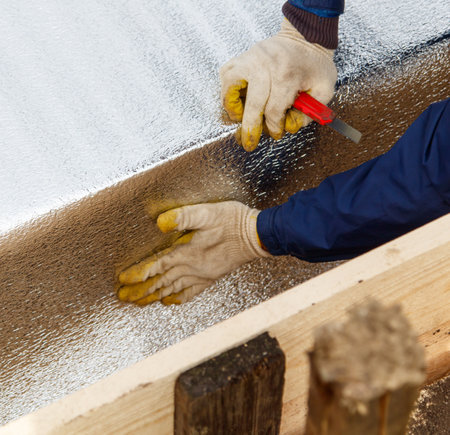Understanding Insulation in the UK Climate
When it comes to keeping British homes cosy and energy-efficient, understanding insulation is absolutely essential. The UK’s unique climate brings its own set of challenges—think chilly winters, damp weather, persistent draughts, and unpredictable temperature swings. These factors make insulation not just a nice-to-have but a necessity for every household aiming to stay comfortable while keeping costs down.
Insulation acts as a barrier, reducing the transfer of heat between the inside and outside of your home. In the UK, this means keeping the warmth in during those long winter months, and preventing excessive heat from creeping indoors during the occasional summer heatwave. But there’s more: proper insulation also tackles common British problems such as condensation and mould growth caused by dampness, as well as cold spots that make certain rooms uncomfortable to use.
One of the biggest incentives for insulating your home in Britain is the potential savings on energy bills. With gas and electricity prices frequently on the rise, cutting down on heating costs is a priority for many households. Effective insulation ensures you’re not losing precious warmth through walls, roofs, floors, or windows—making every pound spent on heating go further.
Here’s a quick look at why insulation matters so much in UK homes:
Common UK Home Issue |
How Insulation Helps |
|---|---|
| Damp & Condensation | Reduces moisture build-up by maintaining even indoor temperatures |
| Draughts | Blocks cold air from entering and warm air from escaping |
| High Energy Bills | Lowers heating demand, saving money year-round |
| Mould Growth | Prevents cold surfaces where mould can thrive |
| Uncomfortable Rooms | Keeps every room warm and usable all year round |
By getting to grips with how insulation works within the context of British weather and housing stock—from Victorian terraces to modern flats—you’ll be better equipped to choose the right approach for your DIY project. Investing time and effort into proper insulation isn’t just about comfort; it’s about protecting your property, improving your quality of life, and making smart savings for years to come.
2. Types of Insulation Materials
Choosing the right insulation material is crucial for UK homeowners seeking comfort, energy efficiency, and savings on utility bills. There are several options available, each with its own pros and cons depending on your budget, property type, and sustainability goals. Let’s break down the most popular choices:
Traditional Insulation Materials
| Material | Description | Best For | Budget-Friendliness |
|---|---|---|---|
| Fibreglass | A classic choice, fibreglass comes in rolls or batts and is known for its affordability and ease of installation. | Lofts, walls, between joists in floors | £ (Very cost-effective) |
| Mineral Wool | Made from volcanic rock or recycled slag, mineral wool offers excellent fire resistance and soundproofing. | Walls, lofts, floors where additional sound insulation is needed | ££ (Moderately priced) |
Eco-Friendly & Modern Alternatives
| Material | Description | Best For | Sustainability | Cost |
|---|---|---|---|---|
| Sheep’s Wool | A natural, breathable option that regulates humidity and is safe to handle—ideal for eco-conscious households. | Lofts, walls in period homes, timber frames | High – renewable resource, biodegradable | £££ (Pricier than synthetics) |
| PIR Boards (Polyisocyanurate) | Rigid foam boards offering high thermal efficiency with a slim profile—perfect for tight spaces. | Flat roofs, solid walls, underfloor applications | Medium – not natural but extremely energy efficient when installed correctly | ££–£££ (Mid to high range) |
| Recycled Denim/Cotton | Sourced from post-consumer textiles, this option provides good insulation and reduces landfill waste. | Cavity walls, lofts, DIY retrofits in small areas | High – made from recycled materials | ££ (Moderate) |
| Celotex/Kingspan Boards | PIR/PUR foam boards branded for superior performance; widely used in new builds across the UK. | Walls, floors, roofs needing maximum insulation in minimal space | Medium – synthetic but durable and effective at reducing heating costs long-term | ££–£££ (Mid to high range) |
| Spray Foam Insulation | This modern solution expands to fill gaps—great for hard-to-reach places but requires professional installation. | Cavities, roofs with awkward shapes or difficult access points | Low – chemical-based but very effective for airtightness | £££ (Expensive upfront but can yield significant savings over time) |
Quick Comparison: Which Material Suits Your Needs?
If you’re looking for a quick win on a tight budget, fibreglass or mineral wool will do the job. For those keen on green living, sheep’s wool or recycled cotton offers peace of mind and eco-credentials. When space is at a premium or you need top-tier thermal performance (especially in modern builds), PIR or Celotex boards are your best bet. Always consider the unique demands of your property—age, structure type, and moisture levels—before making your final decision.
DIY Tip:
If you’re handy and aiming to save on labour costs, fibreglass rolls or mineral wool batts are easiest to install yourself. However, always wear protective gear when handling these materials!
Next Steps:
The right insulation material sets the foundation for a warmer home and lower energy bills. In the next section, we’ll explore the main benefits of each insulation type so you can make an informed choice tailored to your UK home’s specific needs.

3. Benefits of Proper Home Insulation
When it comes to UK homes, investing in proper insulation offers a wealth of advantages that go beyond simply keeping warm. Here are some key benefits tailored specifically for British households:
Lowering Heating Costs
Energy bills in the UK can be particularly high during the colder months, with many families feeling the pinch as they try to keep their homes comfortable. Proper insulation acts as a barrier, reducing heat loss through walls, roofs, and floors. This means your central heating system doesnt have to work overtime, which translates into significant savings on your energy bills year after year.
| Insulation Area | Estimated Annual Savings* |
|---|---|
| Loft Insulation | Up to £355 |
| Cavity Wall Insulation | Up to £280 |
| Floor Insulation | Up to £110 |
*Savings based on an average semi-detached house (Source: Energy Saving Trust)
Increasing Comfort During Chilly Winters
The British winter is notorious for its damp chill. Effective insulation keeps more warmth inside your home, ensuring even temperatures across rooms and eliminating cold draughts. Whether you live in a Victorian terrace or a modern flat, upgraded insulation makes every room feel cosier without constantly adjusting the thermostat.
Supporting Sustainability Goals
With the UK committed to ambitious climate targets, insulating your home is a straightforward way to do your bit for the environment. Less energy used for heating means fewer carbon emissions. Many local councils even offer grants or incentives for homeowners looking to make sustainable upgrades.
Main Environmental Benefits:
- Reduces carbon footprint: Lower gas and electricity usage leads to decreased greenhouse gas emissions.
- Conserves resources: Improved efficiency reduces demand on national energy grids.
- Boosts property value: Well-insulated homes often achieve higher EPC ratings, making them more attractive on the market.
DIY Tip:
If you’re keen on saving money and love a good project, many types of insulation—like loft rolls or pipe lagging—can be fitted yourself with basic tools and some patience. Always check government schemes for financial support before starting!
4. DIY Installation Tips & Tricks
Tackling insulation as a DIY project can save a tidy sum while giving you full control over your home’s energy efficiency. Here’s a step-by-step guide to help you insulate lofts, walls, and floors in line with UK regulations, using materials readily available at local merchants like Wickes or B&Q.
Loft Insulation
Materials Needed:
| Material | Typical Cost (per m²) | Where to Buy |
|---|---|---|
| Mineral wool rolls | £5-£7 | B&Q, Wickes |
| PPE (gloves, mask) | £5-£10 total | Screwfix, Toolstation |
| Measuring tape & knife | N/A (usually owned) | N/A |
Step-by-Step Guide:
- Clear the loft of any stored items and check for wiring or damp issues.
- Measure joist gaps; standard is 400mm or 600mm apart in the UK.
- Unroll mineral wool between joists to the recommended depth (270mm).
- Layer additional insulation crosswise if needed for extra thickness.
- Avoid compressing the material—it reduces effectiveness.
- Wear PPE to prevent irritation from fibres.
Top Tip: Don’t cover downlights—use fire-rated covers if needed!
Cavity Wall Insulation (Internal Dry Lining Method)
Materials Needed:
| Material | Approximate Cost | Availability |
|---|---|---|
| PIR boards (e.g., Celotex) | £15-£20 per sheet | B&Q, Jewson |
| Adhesive/Mechanical fixings | £10-£20 per wall | Screwfix, Wickes |
| Tape & sealant | £5-£10 total | B&Q, Screwfix |
Step-by-Step Guide:
- Check for damp—address before starting insulation.
- Cut PIR boards to fit wall dimensions tightly.
- Fix boards using adhesive or mechanical fixings as per manufacturer guidance.
- Tape all joints and seal edges to prevent thermal bridging.
- If plasterboarding over, secure firmly and finish as usual.
Bargain Alert: PIR offcuts are often discounted at builders’ merchants!
Floor Insulation (Suspended Timber Floors)
Materials Needed:
| Material | Cost Estimate (per m²) | Main Suppliers |
|---|---|---|
| Mineral wool batts/slabs | £6-£8 | B&Q, Travis Perkins |
| Nets/support wires | £10-£15 per room | Screwfix, Wickes |
| PPE (mask & gloves) | See above loft section | – |
Step-by-Step Guide:
- Lift floorboards carefully—label them for easy reinstallation.
- Lay mineral wool between joists, supported by netting or wire to stop sagging.
- Avoid blocking airbricks—ventilation is key to prevent rot under UK Building Regs!
- Nail floorboards back into place securely.
Penny Pincher’s Tip: Reuse lifted boards instead of buying new ones!
Important Safety & Legal Points (UK Specific):
- If your property is listed or in a conservation area, check with your local authority before making changes.
- Certain types of cavity wall insulation must be installed by certified professionals under UK law—DIY only applies to internal dry lining or loft/floor insulation unless otherwise permitted.
- If unsure about electricals or structural issues, consult a qualified tradesperson for safety’s sake.
- Dispose of waste responsibly at your council recycling centre—many offer free disposal for insulation offcuts!
This wallet-friendly approach lets you boost comfort and cut bills without breaking the bank. Always follow UK-specific guidelines and enjoy warmer winters ahead!
5. Professional vs. DIY: When to Call in the Experts
Deciding whether to insulate your home yourself or hire a professional is an important step for UK homeowners looking to save on energy bills and stay cosy year-round. Let’s break down when it makes sense to go the DIY route, and when you should seriously consider bringing in certified British experts.
DIY Insulation: When It’s Practical
Many simple insulation projects can be completed by handy homeowners, especially if you’re aiming to keep costs down. Tasks such as laying loft insulation rolls, sealing draughts around doors and windows, or fitting pipe lagging are usually straightforward and require only basic tools available from your local B&Q or Wickes. DIY is a great option if:
- You have easy access to the area (e.g., open lofts, exposed pipes).
- The materials required are non-specialist (loft rolls, foam strips).
- You feel confident with measuring, cutting, and safe installation.
Legal & Safety Considerations
While DIY can be budget-friendly, there are strict regulations in the UK surrounding certain insulation types—especially those that impact fire safety or require structural modifications. For example, cavity wall insulation often requires professional assessment due to damp risks and building regulations compliance.
When to Hire Certified UK Professionals
Complex insulation jobs usually demand expertise and professional equipment. Hiring a qualified installer (look for TrustMark or CIGA accreditation) not only ensures proper workmanship but also protects your warranty and resale value. Consider calling in the pros if:
- You’re dealing with cavity wall, external wall, or underfloor insulation.
- Your property is listed or located in a conservation area (planning permission may be needed).
- There are concerns about damp, ventilation, or existing damage.
- You want access to government grants or schemes that require certified work.
DIY vs. Professional: Quick Comparison
| Project Type | DIY Suitable? | Professional Required? |
|---|---|---|
| Loft Insulation (Rolls) | Yes | No |
| Draught Proofing | Yes | No |
| Cavity Wall Insulation | No | Yes (Due to regulations) |
| Solid Wall Insulation | No | Yes (Specialist job) |
| Pipes & Tanks Lagging | Yes | No |
The Peace of Mind Factor
Tackling what you can yourself will definitely help stretch your budget further—but when in doubt, especially regarding legal requirements or specialist techniques, investing in a certified pro is worth every penny for long-term comfort, safety, and compliance with UK standards.
6. Insulation Grants and Budgeting in the UK
Making your UK home energy efficient doesn’t have to break the bank. Thanks to government grants, local council schemes, and smart budgeting tips, you can significantly reduce the cost of insulation. Below, we’ll walk you through the latest financial support options and DIY strategies to keep your project affordable.
Government Grants for Insulation
The UK government offers several schemes to help households improve their insulation. Here’s a quick comparison of the main options available:
| Scheme | Who Can Apply | What’s Covered |
|---|---|---|
| Great British Insulation Scheme | Homeowners & private renters (with landlord approval) | Cavity wall, loft, and underfloor insulation |
| ECO4 (Energy Company Obligation) | Low-income & vulnerable households | Wide range including solid wall, cavity, loft, and floor insulation |
| Local Authority Flex | Households not qualifying for ECO4 but meeting local criteria | Varies by council; often includes similar measures as ECO4 |
Local Council Schemes
Many councils across England, Scotland, Wales, and Northern Ireland offer their own energy efficiency grants or discounts. Check with your local authority for:
- Free insulation assessments
- Subsidised or fully funded installation for eligible residents
- Bespoke schemes for historic or hard-to-treat properties
Budget-Friendly DIY Approaches
Simple Steps to Save Money on Insulation
- Focus first on loft and draught-proofing – these are usually cheapest and quickest to DIY.
- Shop around for materials at local builders’ merchants or online deals.
- If hiring a professional, get multiple quotes and ask about grant eligibility.
Savings Example Table
| Insulation Type | DIY Cost (Approx.) | Professional Cost (Approx.) |
|---|---|---|
| Draught Proofing (doors/windows) | £50-100 | £150-250 |
| Loft Insulation (rolls) | £200-400 | £500-800 |
| Cavity Wall Insulation | N/A (pro only) | £700-1,500* |
*Grants may cover up to 100% of cost for eligible households.
Top Tip:
If you’re unsure where to start, contact your local council or visit the official government websites for up-to-date information on available grants and application processes. Always double-check eligibility before making any purchase or booking installation.


